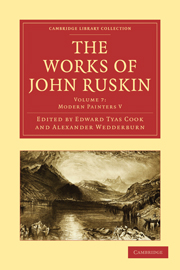Book contents
- Frontmatter
- Contents
- LIST OF ILLUSTRATIONS
- INTRODUCTION TO THIS VOLUME
- BIBLIOGRAPHICAL NOTE
- Modern Painters, Vol. V.
- PREFACE
- PART VI “OF LEAF BEAUTY”
- PART VII “OF CLOUD BEAUTY”
- PART VIII “OF IDEAS OF RELATION:—FIRST, OF INVENTION FORMAL”
- PART IX “OF IDEAS OF RELATION:—SECOND, OF INVENTION SPIRITUAL”
- CHAP. I THE DARK MIRROR
- CHAP. II THE LANCE OF PALLAS
- CHAP. III THE WINGS OF THE LION
- CHAP. IV DÜRER AND SALVATOR
- CHAP. V CLAUDE AND POUSSIN
- CHAP. VI RUBENS AND CUYP
- CHAP. VII OF VULGARITY
- CHAP. VIII WOUVERMANS AND ANGELICO
- CHAP. IX THE TWO BOYHOODS
- CHAP. X THE NEREID'S GUARD
- CHAP. XI THE HESPERID ÆGLÉ
- CHAP. XII PEACE
- EPILOGUE (1888)
- APPENDIX
- Plate section
CHAP. I - THE DARK MIRROR
Published online by Cambridge University Press: 07 September 2011
- Frontmatter
- Contents
- LIST OF ILLUSTRATIONS
- INTRODUCTION TO THIS VOLUME
- BIBLIOGRAPHICAL NOTE
- Modern Painters, Vol. V.
- PREFACE
- PART VI “OF LEAF BEAUTY”
- PART VII “OF CLOUD BEAUTY”
- PART VIII “OF IDEAS OF RELATION:—FIRST, OF INVENTION FORMAL”
- PART IX “OF IDEAS OF RELATION:—SECOND, OF INVENTION SPIRITUAL”
- CHAP. I THE DARK MIRROR
- CHAP. II THE LANCE OF PALLAS
- CHAP. III THE WINGS OF THE LION
- CHAP. IV DÜRER AND SALVATOR
- CHAP. V CLAUDE AND POUSSIN
- CHAP. VI RUBENS AND CUYP
- CHAP. VII OF VULGARITY
- CHAP. VIII WOUVERMANS AND ANGELICO
- CHAP. IX THE TWO BOYHOODS
- CHAP. X THE NEREID'S GUARD
- CHAP. XI THE HESPERID ÆGLÉ
- CHAP. XII PEACE
- EPILOGUE (1888)
- APPENDIX
- Plate section
Summary
§ 1. In the course of our inquiry into the moral of landscape (Vol. III., Chap. XVII.), we promised at the close of our work to seek for some better, or at least clearer, conclusions than were then possible to us. We confined ourselves in that chapter to the vindication of the probable utility of the love of natural scenery. We made no assertion of the usefulness of painting such scenery. It might be well to delight in the real country, or admire the real flowers and true mountains. But it did not follow that it was advisable to paint them.
Far from it. Many reasons might be given why we should not paint them. All the purposes of good which we saw that the beauty of Nature could accomplish, may be better fulfilled by the meanest of her realities, than by the brightest of imitations. For prolonged entertainment, no picture can be compared with the wealth of interest which may be found in the herbage of the poorest field, or blossoms of the narrowest copse. As suggestive of supernatural power, the passing away of a fitful raincloud, or opening of dawn, are in their change and mystery more pregnant than any pictures. A child would, I suppose, receive a religious lesson from a flower more willingly than from a print of one; and might be taught to understand the nineteenth Psalm, on a starry night, better than by diagrams of the constellations.
- Type
- Chapter
- Information
- The Works of John Ruskin , pp. 253 - 262Publisher: Cambridge University PressPrint publication year: 2010First published in: 1903

